Today we wanted to focus on a small system, the Supermicro E300-9D-4CN8TP which is a system we use around the STH labs as a firewall appliance. We purchased this system some time ago and had an opportunity recently to move the system and do a review in the process. The system itself is a compact edge platform built inside Supermicro’s E300 chassis that houses a Xeon D, four 1GbE, and four 10GbE network ports. In our review, we are going to take a look at how this system is constructed.
Supermicro E300-9D-4CN8TP Hardware Overview
As we have been doing in recent reviews, we have the hardware overview for this system split into two parts. First, we are going to look at the exterior of the chassis. We will then get into the interior of the system. If you want to check out a different format, we have a YouTube video on this one.
As always, we suggest opening this video in a YouTube tab for a better viewing experience.
Supermicro E300-9D-4CN8TP External Overview
The system itself is 10″ x 1.7″ x 8.9″ or 254mm x 43mm x 226mm. We normally do not start server reviews with dimensions. In this case, that is an extremely important facet of the server since it is designed to be an edge device instead of a rackmount-first solution (there is a rackmount kit available.) The front of the server is basically power buttons, and status LEDs but the majority of the system’s front is for airflow.
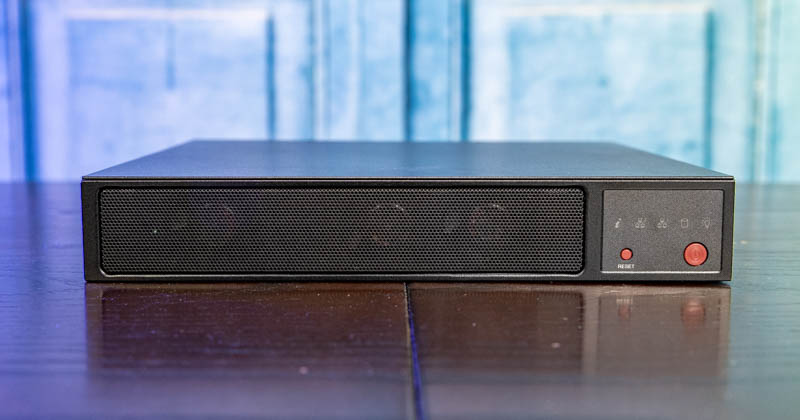
We will note here that if you are looking for hot-swap drives, this is not the device for you. As you can see, there are no hot-swap drive trays.
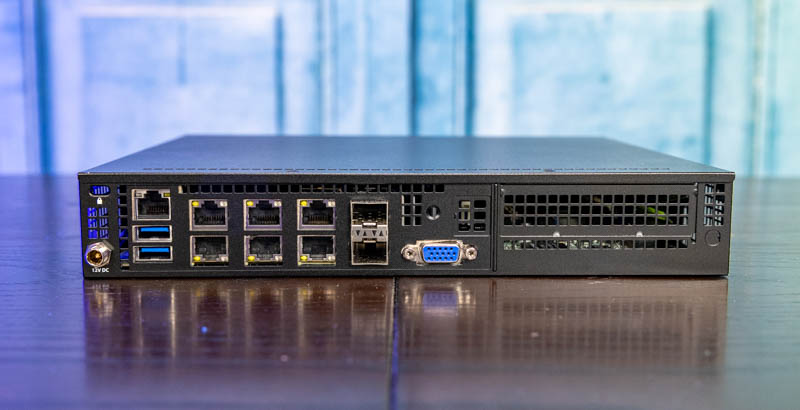
On the rear of the unit, or what we feel many of our readers may view as the front, we have where the key features of the unit are. The first feature is the DC input. The unit uses an external power supply which is a 150W unit (MCP-250-10128-0N). The key feature here is that the DC jack has threads so the power supply neatly couples with the system and locks in place preventing accidental removal. That is a big deal for an edge appliance. The input for the 150W power adapter is a C14 so one can use a C13 cable with the adapter. We wish there was a locking version of this as well, but that is a more secure socket than the average non-locking DC power brick.
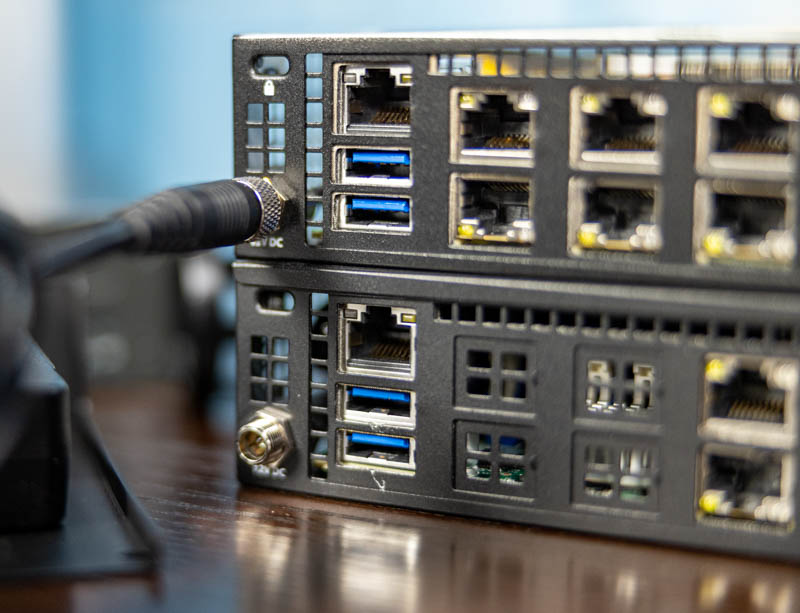
One also gets a plentiful I/O panel. As we would expect there is a legacy VGA port, two USB 3.0 ports, and a RJ45 port for the out-of-band AST2500 management.
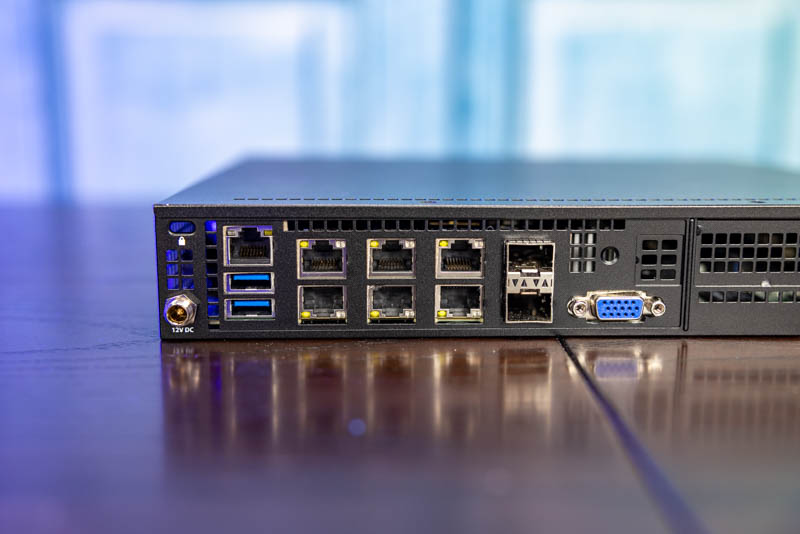
Networking goes well beyond this one gets four 1GbE ports powered by an Intel i350-am4 controller. The 10Gbase-T ports are powered via an Intel X557 NIC. The dual SFP+ 10GbE ports are powered by the Intel Xeon D-2123IT. That is a lot of connectivity options in a small package. We will have the block diagram later in this review if you want to see how this is connected.
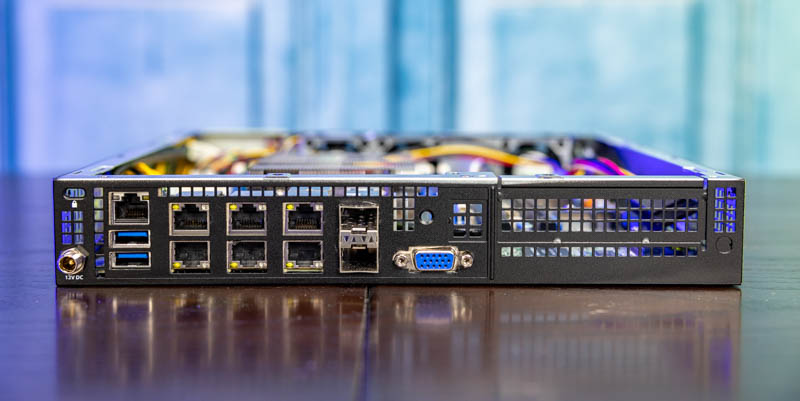
On the opposite side of the chassis, we see only air vents. There is an optional low-profile riser and rear chassis piece for those that want to add an expansion card. This could be yet another NIC or even a dual M.2 SSD expander board.
The outside of the chassis is great, but let us get inside to see what else the system has to offer since that gets to configuration options.

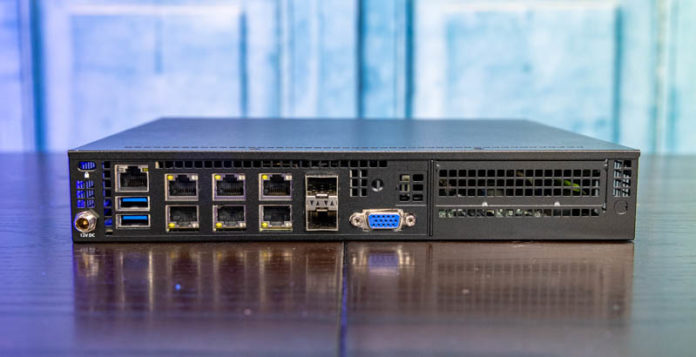



Thank You for your solid review of my dream motherboard! Yes, I am one of those Supermicro X11SDV-4C-TP8F fanboys;). Best Regards, ABQ :)
I know as the readers of STH we do not like that STH is now doing video, but the video for this one is like a doctoral dissertation on this system and the current state of the Xeon D-2100 series.
I’d say you should make the Xeon D insight around pricing from the video its own article. That’s a stinger in the video.
Anyone that has one and can comment on how picky this system is regarding SFP+ optics/DAC? I have the previous generation and with most Intel drivers these started requiring Intel coded DACs halfway through their lifecycle, causing major issues when this happened after scheduled updates on devices in the field.
Intel forgot to put a QAT in this processor :)
Not great for IPSEC, openssl and crypto workloads.
VPNs are quite popular in 2021.
But they offer nice xeon-d models with hardware crypto acceleration.
The Supermicro SuperServer E300-9D-8CN8TP has some distinct advantages. The E300-9D-8CN8TP sports an Intel® Xeon® D-2146NT, which has Intel Quick Assist Technology. The reviewed Supermicro SuperServer E300-9D-4CN8TP sports the more limited Intel® Xeon® D-2123IT, which lacks Intel QAT. The E300-9D-8CN8TP adds 4C and a sizeable $500 on Amazon. An alternative might be to add an Intel QAT accelerator, but there would need to be available power and you’d lose the PCIe slot. Used Intel QAT accelerators are available on eBay for cheap.
it’s seems a great option for home server but for 8-900 $ it’s to high
The Supermicro X11SDV-4C-TP8F motherboards are $449 NIB & free shipping, if you already have a case.
@Fred Tang: I am a long-time reader too and enjoy the videos.. So it is not all of us.
I was sceptic at first, but it provides additional value and is not just the article script in video form.
I urge other video sceptics to give it a try!
And to the die-hard anti-video crowd: Any tech journalist knows, that without YouTube, traditional online journalism is dead as disco. It is a matter of survival, plain and simple.
@ABQ Supermicro X11SDV-4C-TP8F in italy is over 700€ on ebay 500$ plus 2-300$ of duties
usa’s price is very differente for europeans people for costums duties and VAT (in italy is 22%)
BMC/IPMI licenses are BS, which is why I’m happy purchasing Gigabyte/ASrock Rack.
I’m running 2 of these for 2 Years 7/24 now without any Problems. Perfect for a VMWARE Home-Lab, but not only. I’ve replaced the (loud) Stock Fan’s with Noctua Fan’s – they are not so loud and cools good (Noctua NF-A4x20 PWM). Also added the RSC-RR1U-E8 expansion for the low Profile Riser Card (AOC-SLG3-2M2-O), so you can run 2 additional M.2 NVMe SSDs. Perfect for running/testing VSAN (Robo). As i was so satisfied with this Supermicro-Solution i run now 2 additional 8-Core Versions of this Barebones (E300-9D-8CN8TP) for running/testing “remote-site replication” scenarios. I can only recommend this Barebones.
Hi Giuse! Did you replace the fans of the E300 chassis with Noctua fans? Are you happy with them? Did it get silent?
Hi Giuse! greeting,
do you run E300-9D-4CN8TP or E300-9D-8CN8TP,
I’m looking for my expansion of 2x for workload home lab (VMware SDDC Stack) on E300-9D-8CN8TP?
do you advice for the same.
SYS-E300-9D-8CN8TP
Release Date: Nov 2018 (EOL: Q1 2025)
CPU: Intel Xeon D-2146NT (8c/16t)
Memory: 512GB
Storage: 1 x M.2 (Additional 1 x M.2 possible with PCIe Add-in-Card or 2 x M.2 possible with AOC-SLG3-2M2)
Max Devices: 3
Network: 2 x 10GbE, 2 x 10GbE (SFP+), 4 x 1GbE, 1 x 1GbE (IPMI)
VMware HCL: Yes (supports up to vSphere 7.0 Update 1)
which one you recommend:
1-https://www.amazon.com/gp/product/B07JN5T2RT/ref=ox_sc_saved_title_6?smid=AEELF2HAVZFED&psc=1
2-https://www.amazon.com/gp/product/B07RCN114X/ref=ox_sc_saved_title_5?smid=ATVPDKIKX0DER&psc=1